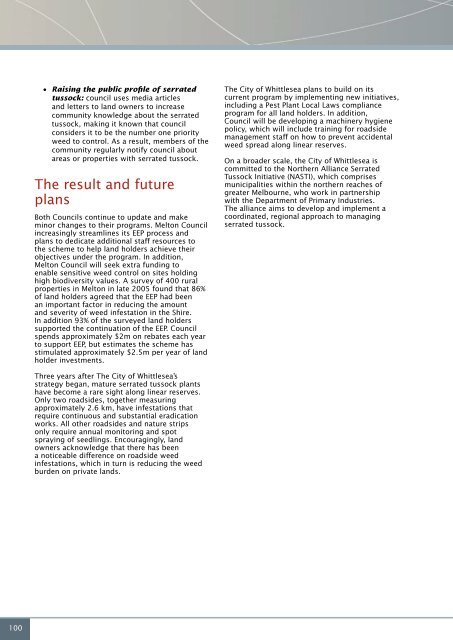Section 5 Case studies - Weeds Australia
Section 5 Case studies - Weeds Australia
Section 5 Case studies - Weeds Australia
Create successful ePaper yourself
Turn your PDF publications into a flip-book with our unique Google optimized e-Paper software.
• Raising the public profile of serrated<br />
tussock: council uses media articles<br />
and letters to land owners to increase<br />
community knowledge about the serrated<br />
tussock, making it known that council<br />
considers it to be the number one priority<br />
weed to control. As a result, members of the<br />
community regularly notify council about<br />
areas or properties with serrated tussock.<br />
The result and future<br />
plans<br />
Both Councils continue to update and make<br />
minor changes to their programs. Melton Council<br />
increasingly streamlines its EEP process and<br />
plans to dedicate additional staff resources to<br />
the scheme to help land holders achieve their<br />
objectives under the program. In addition,<br />
Melton Council will seek extra funding to<br />
enable sensitive weed control on sites holding<br />
high biodiversity values. A survey of 400 rural<br />
properties in Melton in late 2005 found that 86%<br />
of land holders agreed that the EEP had been<br />
an important factor in reducing the amount<br />
and severity of weed infestation in the Shire.<br />
In addition 93% of the surveyed land holders<br />
supported the continuation of the EEP. Council<br />
spends approximately $2m on rebates each year<br />
to support EEP, but estimates the scheme has<br />
stimulated approximately $2.5m per year of land<br />
holder investments.<br />
The City of Whittlesea plans to build on its<br />
current program by implementing new initiatives,<br />
including a Pest Plant Local Laws compliance<br />
program for all land holders. In addition,<br />
Council will be developing a machinery hygiene<br />
policy, which will include training for roadside<br />
management staff on how to prevent accidental<br />
weed spread along linear reserves.<br />
On a broader scale, the City of Whittlesea is<br />
committed to the Northern Alliance Serrated<br />
Tussock Initiative (NASTI), which comprises<br />
municipalities within the northern reaches of<br />
greater Melbourne, who work in partnership<br />
with the Department of Primary Industries.<br />
The alliance aims to develop and implement a<br />
coordinated, regional approach to managing<br />
serrated tussock.<br />
Three years after The City of Whittlesea’s<br />
strategy began, mature serrated tussock plants<br />
have become a rare sight along linear reserves.<br />
Only two roadsides, together measuring<br />
approximately 2.6 km, have infestations that<br />
require continuous and substantial eradication<br />
works. All other roadsides and nature strips<br />
only require annual monitoring and spot<br />
spraying of seedlings. Encouragingly, land<br />
owners acknowledge that there has been<br />
a noticeable difference on roadside weed<br />
infestations, which in turn is reducing the weed<br />
burden on private lands.<br />
100

















